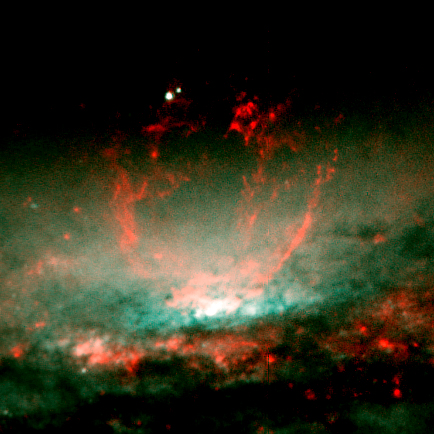Recently I have been looking at a series of papers detailing some hydrodynamic simulations performed by a research group in Australia (incidentally they are using a modification of a hydro code called VH-1 originally written by John Blondin at NC State University, just down the road from me. Think U of U and BYU, complete with similar colors, only BYU has dark blue and UNC has light blue. Anyway back to my post...). In their second paper the group finds "that the ability of the cloud to radiate heat is crucial for its survival", and that a non-uniform cloud will survive longer than a uniform cloud when hit by an expanding shockwave.
Now for a brief rundown of their research: After combining the hydro code VH-1 with a thermal cooling code called MAPPINGS III they ran their simulations of uniform spherical clouds and non-uniform fractal clouds. They introduced a shockwave that would accelerate and fragment the cloud (the shockwave would come from a supernova or an AGN). The motivation was to find out how filamentary structures are formed as observed in the center of galaxies such as NGC 3079 (picture credit to my adviser):
[Close up of the center]
These bright H-alpha regions are somewhat of a mystery as to how they form exactly. And the purpose of the simulations was to find out how they formed and what they look like in 3D. Part of the problem is that if you introduce a strong interstellar wind, such as from an AGN or a series of supernovas then according to previous simulations, the clouds of dense interstellar gas would not survive long enough to for structures like this. So this group in Australia tried performing the simulations, but included thermal cooling and shocked non-uniform clouds. When they did this they found that even though the non-uniform clouds will fragment faster than the uniform (spherical) clouds, the effect of thermal cooling causes the fragments to live longer than the larger uniform cloud. This allows a cloud to survive long enough to form filaments such as the ones observed above.
If you think about it, what is going on here is that when both the uniform and non-uniform clouds are shocked they will both heat up and begin radiating away heat. But the non-uniform clouds, due to their inherent instabilities will fragment into many smaller clouds thus increasing the surface area to volume ratio. Because the amount of heat stored by a cloud depends on its volume but the rate of heat loss depends on the surface area, if you keep the cloud together (i.e. uniform) then when it heats up it will not radiate as efficiently as the cloud with more surface area. Hence why car radiators and other similar devices have cooling fins.
If you had asked most people to predict which cloud would last longer, the dense, spherical cloud or the sparse, non-uniform cloud, most would probably say the denser cloud, but it turns out that the non-uniform cloud would last longer because of the non-intuitive concept of radiative cooling.



"If you had asked most people to predict which cloud would last longer, the dense, spherical cloud or the sparse, non-uniform cloud..."
ReplyDeleteI admit, initially I would have said the spherical cloud too but the increased surface area of the non-uniform cloud radiating extra heat explanation makes a lot of sense why that one will survive.
Sort of like cooling mechanisms in stars?
Dang, I thought from the title of this post that if I want to live a long life I just need to be a rebel. =:)
ReplyDelete